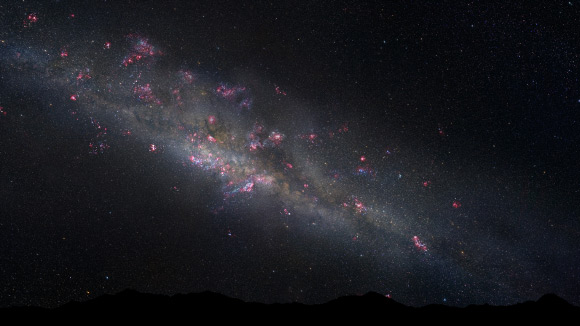Using Hubble’s deep-sky surveys, NASA astronomers have studied the evolution of 400 Milky Way-like galaxies to show how our own Galaxy looked like when it was formed.

This is an artist’s concept of the early Milky Way. Image credit: NASA / ESA / Z. Levay, STScI, AURA.
According to the findings of two studies published in the Astrophysical Journal (study #1 and study #2), the Milky Way likely began as faint, blue, low-mass object containing lots of gas.
Our Galaxy probably was a flat disk with a bulge in the middle, both of which grew simultaneously into the majestic spiral seen today.
“For the first time, we have direct images of what the Milky Way looked like in the past,” said Dr Pieter van Dokkum of Yale University, a co-author on both studies.
“Of course, we can’t see the Milky Way itself in the past. We selected galaxies billions of light-years away that will evolve into galaxies like the Milky Way.”
“By tracing the Milky Way’s siblings, we find that our Galaxy built up 90 percent of its stars between 11 billion and 7 billion years ago, which is something that has not been measured directly before.”
At the peak of star formation, when the Universe was about 4 billion years old, the Milky Way-like galaxies were pumping out about 15 stars a year. Our Galaxy today is creating only one star a year.
“You can see that these galaxies are fluffy and spread out. There is no evidence of a bulge without a disk, around which the disk formed later,” said co-author Dr Shannon Patel of Leiden University.
“These galaxies show us the whole Milky Way grew at the same time, unlike more massive elliptical galaxies, in which the central bulge forms first,” said co-author Dr Erica Nelson of Yale University.
______
Bibliographic information: Patel SG et al. 2013. The Structural Evolution of Milky-Way-like Star-forming Galaxies since z ~ 1.3. ApJ 778, 115; doi: 10.1088/0004-637X/778/2/115
Pieter G. van Dokkum et al. 2013. The Assembly of Milky-Way-like Galaxies Since z ~ 2.5. ApJ 771, L35; doi: 10.1088/2041-8205/771/2/L35







